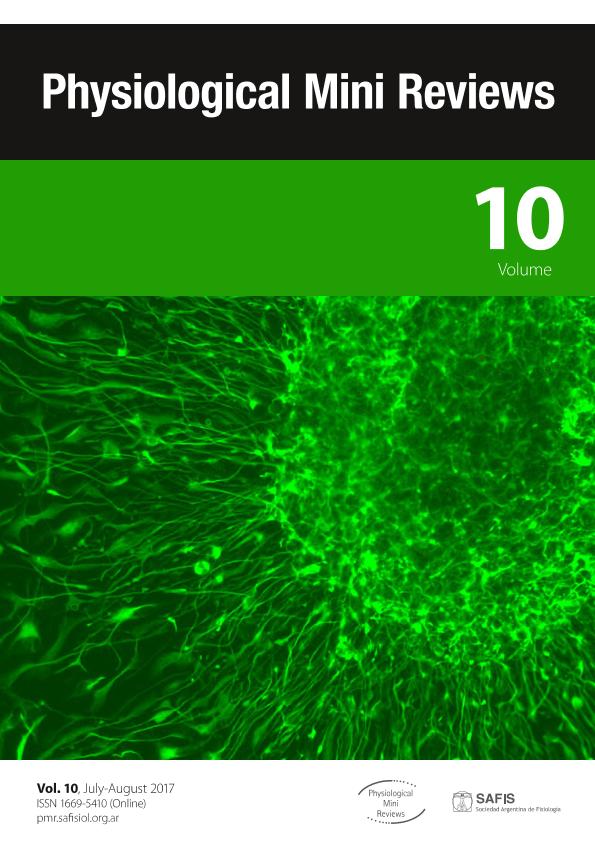Mostrar el registro sencillo del ítem
dc.contributor.author
Perez, Nestor Gustavo

dc.date.available
2018-06-20T01:33:40Z
dc.date.issued
2017-08
dc.identifier.citation
Perez, Nestor Gustavo; Mineralocorticoid receptor activation following acute myocardial stretch; Sociedad Argentina de Fisiología. Centro de Investigaciones Cardiovasculares. Universidad Nacional de La Plata; Physiological Mini Reviews; 10; 4; 8-2017; 37-47
dc.identifier.issn
1669-5410
dc.identifier.uri
http://hdl.handle.net/11336/49490
dc.description.abstract
Myocardial stretch induces a two-phase increase in developed force. The first phase occurs immediately, is due to an increase in myofilament Ca2+ responsiveness, and is the expression of the Frank-Starling mechanism. The second phase, gradually developed, results from an increase in intracellular Ca2+ concentration and is known as ?slow force response? (SFR) to stretch. Characterization of the subcellular basis of the increase in Ca2+ responsible for the SFR development was an important objective of our laboratory group during last two decades. We have compiled enough evidence to suggest that the SFR is the mechanical expression of an autocrine/paracrine loop of intracellular signals leading to the reactive oxygen species (ROS)-mediated activation of redox-sensitive kinases that activate (phosphorylate) the cardiac Na+/H+ exchanger (NHE1), increasing intracellular Na+, and consequently, Ca2+ concentration. Recently, we demonstrated that mineralocorticoid receptor (MR) activation after stretch is critical for the progression of this complex signaling pathway. Interestingly, clinical evidence assigns a detrimental role to MR activation in the pathophysiology of heart failure (HF), in which cardiac wall stretch is an important triggering factor. The aim of this mini-review is not only to share our own experience describing novel non-genomic effects of MR activation after acute myocardial stretch and the physiological consequences, but also to discuss other possible pathophysiological implications, as well as the potential clinical impact of this important discovery.
dc.format
application/pdf
dc.language.iso
eng
dc.publisher
Sociedad Argentina de Fisiología. Centro de Investigaciones Cardiovasculares. Universidad Nacional de La Plata
dc.rights
info:eu-repo/semantics/openAccess
dc.rights.uri
https://creativecommons.org/licenses/by-nc-sa/2.5/ar/
dc.subject
Mineralocorticoid Receptor
dc.subject
Myocardial Stretch
dc.subject
Clinical Impact
dc.subject.classification
Fisiología

dc.subject.classification
Medicina Básica

dc.subject.classification
CIENCIAS MÉDICAS Y DE LA SALUD

dc.title
Mineralocorticoid receptor activation following acute myocardial stretch
dc.type
info:eu-repo/semantics/article
dc.type
info:ar-repo/semantics/artículo
dc.type
info:eu-repo/semantics/publishedVersion
dc.date.updated
2018-06-08T14:28:28Z
dc.identifier.eissn
1669-5410
dc.journal.volume
10
dc.journal.number
4
dc.journal.pagination
37-47
dc.journal.pais
Argentina

dc.journal.ciudad
La Plata
dc.description.fil
Fil: Perez, Nestor Gustavo. Consejo Nacional de Investigaciones Científicas y Técnicas. Centro Científico Tecnológico Conicet - la Plata. Centro de Investigaciones Cardiovasculares ; Argentina
dc.journal.title
Physiological Mini Reviews
dc.relation.alternativeid
info:eu-repo/semantics/altIdentifier/url/http://pmr.safisiol.org.ar/archive/id/96
Archivos asociados
